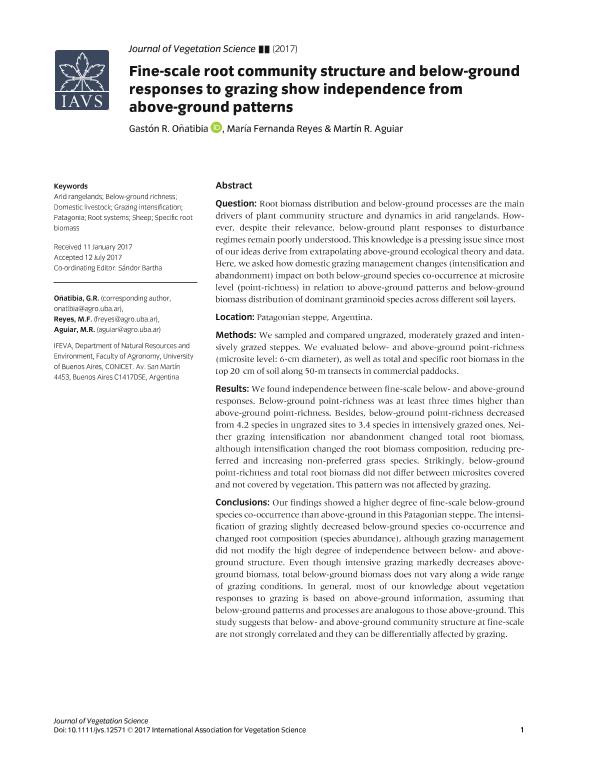Mostrar el registro sencillo del ítem
dc.contributor.author
Oñatibia, Gastón Rafael

dc.contributor.author
Reyes, María Fernanda

dc.contributor.author
Aguiar, Martin Roberto

dc.date.available
2018-08-21T20:09:55Z
dc.date.issued
2017-11
dc.identifier.citation
Oñatibia, Gastón Rafael; Reyes, María Fernanda; Aguiar, Martin Roberto; Fine-scale root community structure and below-ground responses to grazing show independence from above-ground patterns; Wiley Blackwell Publishing, Inc; Journal of Vegetation Science; 28; 6; 11-2017; 1097-1106
dc.identifier.issn
1100-9233
dc.identifier.uri
http://hdl.handle.net/11336/56439
dc.description.abstract
Question: Root biomass distribution and below-ground processes are the main drivers of plant community structure and dynamics in arid rangelands. However, despite their relevance, below-ground plant responses to disturbance regimes remain poorly understood. This knowledge is a pressing issue since most of our ideas derive from extrapolating above-ground ecological theory and data. Here, we asked how domestic grazing management changes (intensification and abandonment) impact on both below-ground species co-occurrence at microsite level (point-richness) in relation to above-ground patterns and below-ground biomass distribution of dominant graminoid species across different soil layers. Location: Patagonian steppe, Argentina. Methods: We sampled and compared ungrazed, moderately grazed and intensively grazed steppes. We evaluated below- and above-ground point-richness (microsite level: 6-cm diameter), as well as total and specific root biomass in the top 20 cm of soil along 50-m transects in commercial paddocks. Results: We found independence between fine-scale below- and above-ground responses. Below-ground point-richness was at least three times higher than above-ground point-richness. Besides, below-ground point-richness decreased from 4.2 species in ungrazed sites to 3.4 species in intensively grazed ones. Neither grazing intensification nor abandonment changed total root biomass, although intensification changed the root biomass composition, reducing preferred and increasing non-preferred grass species. Strikingly, below-ground point-richness and total root biomass did not differ between microsites covered and not covered by vegetation. This pattern was not affected by grazing. Conclusions: Our findings showed a higher degree of fine-scale below-ground species co-occurrence than above-ground in this Patagonian steppe. The intensification of grazing slightly decreased below-ground species co-occurrence and changed root composition (species abundance), although grazing management did not modify the high degree of independence between below- and above-ground structure. Even though intensive grazing markedly decreases above-ground biomass, total below-ground biomass does not vary along a wide range of grazing conditions. In general, most of our knowledge about vegetation responses to grazing is based on above-ground information, assuming that below-ground patterns and processes are analogous to those above-ground. This study suggests that below- and above-ground community structure at fine-scale are not strongly correlated and they can be differentially affected by grazing.
dc.format
application/pdf
dc.language.iso
eng
dc.publisher
Wiley Blackwell Publishing, Inc

dc.rights
info:eu-repo/semantics/openAccess
dc.rights.uri
https://creativecommons.org/licenses/by-nc-sa/2.5/ar/
dc.subject
Arid Rangelands
dc.subject
Below-Ground Richness
dc.subject
Domestic Livestock
dc.subject
Grazing Intensification
dc.subject
Patagonia
dc.subject
Root Systems
dc.subject
Sheep
dc.subject
Specific Root Biomass
dc.subject.classification
Otras Ciencias Biológicas

dc.subject.classification
Ciencias Biológicas

dc.subject.classification
CIENCIAS NATURALES Y EXACTAS

dc.title
Fine-scale root community structure and below-ground responses to grazing show independence from above-ground patterns
dc.type
info:eu-repo/semantics/article
dc.type
info:ar-repo/semantics/artículo
dc.type
info:eu-repo/semantics/publishedVersion
dc.date.updated
2018-08-16T15:11:46Z
dc.journal.volume
28
dc.journal.number
6
dc.journal.pagination
1097-1106
dc.journal.pais
Reino Unido

dc.journal.ciudad
Londres
dc.description.fil
Fil: Oñatibia, Gastón Rafael. Consejo Nacional de Investigaciones Científicas y Técnicas. Oficina de Coordinación Administrativa Parque Centenario. Instituto de Investigaciones Fisiológicas y Ecológicas Vinculadas a la Agricultura. Universidad de Buenos Aires. Facultad de Agronomía; Argentina
dc.description.fil
Fil: Reyes, María Fernanda. Consejo Nacional de Investigaciones Científicas y Técnicas. Oficina de Coordinación Administrativa Parque Centenario. Instituto de Investigaciones Fisiológicas y Ecológicas Vinculadas a la Agricultura. Universidad de Buenos Aires. Facultad de Agronomía; Argentina
dc.description.fil
Fil: Aguiar, Martin Roberto. Consejo Nacional de Investigaciones Científicas y Técnicas. Oficina de Coordinación Administrativa Parque Centenario. Instituto de Investigaciones Fisiológicas y Ecológicas Vinculadas a la Agricultura. Universidad de Buenos Aires. Facultad de Agronomía; Argentina
dc.journal.title
Journal of Vegetation Science

dc.relation.alternativeid
info:eu-repo/semantics/altIdentifier/doi/https://dx.doi.org/10.1111/jvs.12571
dc.relation.alternativeid
info:eu-repo/semantics/altIdentifier/url/https://onlinelibrary.wiley.com/doi/abs/10.1111/jvs.12571
Archivos asociados
